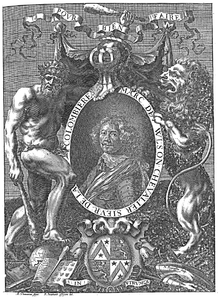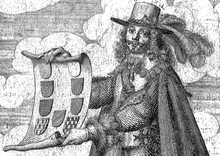Marcus Vulson de la Colombière

Marcus Vulson de la Colombière (†1658 or 1665) or Sieur [Sir] de la Colombière was a French heraldist, historian, poet, minion of the royal court. His name is often spelt as Wulson and also as Volson.
He published several highly successful books on symbols, prophecies, heraldry, dreams etc. He put together all the available knowledge and traditions associated with chivalry. In the 17th century chivalry was practically rediscovered by two genealogists and sycophants in the French court: Colombière and Claude-François Ménestrier after its golden age (1100–1400) and the decline of chivalry, developing its idealized image. Some authors named de la Colombière as the inventor of hatching system of tinctures.
Biography

We have only some fragmented data about his life. Even the 19th century big biographies deliver only incomplete information about him. He was born in a Protestant noble family at the end of the 16th century in Dauphiné. He was a son of Francois, advocat and Michelle Odde de Bonniot.[1] In his youth, he fought for Henry IV. According to a curious anecdote, in 1618 he went to Paris to request grace, after he killed his treacherous wife and her lover.[2]
According to the title pages of his books, (see for example Le Vray Théâtre d´honneur et de Chevalerie, Paris, 1648), he was a member of parliament (self-government) in Paris and the member of the Order of Saint Michael (gentilhomme de la Chambre du Roi et Décoré de l’Ordre de Saint-Michel). By all probability, until 1635 he was staying in Grenoble as he was a royal counselor in the Dauphiné parliament (conseiller du roi en la cour de parlement de Dauphiné). He also published a book in the spirit of the Gallicanism in Geneva that year. (It can be noted that several of the Protestant priests and students at the Geneva University were his kinsmen.) Gallicanism served as a proper means to express his Protestant views in opposition to Catholicism, and he presented them in such a way that it was even appreciated by the state establishment too.
Colombière’s ideas suited the king’s taste too, as a result he left Grenoble and settled down in Paris, where he devoted his entire energy to study heraldry. According to the catalogues of the Bibliothèque Nationale de France, his next book was published in Paris in 1638.
The Dispute of de la Colombière and Petra Sancta

He had wide-ranging correspondence with the most renowned heraldists of his time. For this reason, it could perhaps be concluded that Colombière was right in claiming the title of the inventor of the hatching system, and accusing Silvester Petra Sancta of copying his method and incorrectly publishing it in his 1638 work, one year before the same hatching system was published by de la Colombière. On page 37 of his title La Science Heroïque (1644), Colombière maintains that Petra Sancta simply copied his system without any changes.[3] Colombière also maintains that he showed to Petra Sancta his hatching system in the past. In his citation, de la Colombière also mentions the book publishers and copperplate engravers as the users of the hatching system, thus emphasizing that by using this method on the illustrations, engravers can always designate the tinctures of the copperplates in the same coherent manner. In the title of his 1639 book he directly mentions that hatching is a new method used by copperplate engravings ("suivant l'art des anciens roys d'armes... et une nouvelle méthode de cognoistre les métaux et couleurs sur la taille-douce"). The book was published by Melchior Tavernier, and the engraved fontoispiece was made by Abraham Bosse. Maybe he was also the author of the remaining engravings inside the book. However, de la Colombière contributed to the drawing and engraving of illustrations too, as we can see from his signature under the armorial genealogical table of his supporter, Denys de Salvaing.
In his 1639 title, de la Colombière published a hatching table, but did not mention Petra Sancta. The reason probably was that in 1638 the publication of his book was already in progress and/or he did not know nothing about the same hatching method published by Petra Sancta in 1638. He had also described the way of hatchings by words, and published another hatching table in 1644.
Ottfried Neubecker maintains that the hatching system in heraldry was invented by de la Colombière and not Petra Sancta who only popularized the system through his second treatise titled Tesserae gentilitia, published in 1638.
Works
- De la Puissance du pape et des libertés de l'Église gallicane. Par Marc de Vulson, conseiller du roi en la cour de parlement de Dauphiné. Genève: Iean de Tournes & Iaques de la Pierre, 1635
- Recueil de plusieurs pièces et figures d'armoiries obmises par les autheurs qui ont escrit jusques icy de cette science, blasonnées par le sieur Vulson de La Colombière,... suivant l'art des anciens roys d'armes, avec un discours des principes et fondemens du blason, et une nouvelle méthode de cognoistre les métaux et couleurs sur la taille-douce. - Paris : M. Tavernier, 1639. - In-4°, pièces, limin., 14 p., armoiries, 75 pl. d'armoiries, la plupart coloriées, frontisp. gr. par Abraham Bosse.
(New edition Paris, 1689)
- La Science heroiqve, traitant de la noblesse, de l'origine des armes de leurs blasons, & symboles, des tymbres, bourlets, couronnes, cimiers, lambrequins, supports, & tenans, & autres ornements de l'escu ; de la deuise, & du cry de guerre, de l'escu pendant & des pas & emprises des anciens cheualiers, des formes differentes de leurs tombeaux ; et des marques exterieures de l'escu de nos roys, des reynes, & enfans de France, & des officiers de la couronne, et de la maison du roy. Paris 1639 and 1644
- Le vrai Théâtre d'honneur et de chevalerie, ou le miroir héroïque de la noblesse... par Marc de Vulson, sieur de La Colombière... Paris : chez A. Courbé, 1638. - 2 vol. in-fol.
- Traité de la Physiognomie, In: Le Palais des curieux..., Paris, 1666.
-
Description of hatching method, Colombière 1639
-
Description of hatching method, Colombière 1639
-
Description of hatching method, Colombière 1639
-
The hatching table, Colombière 1639
-
Engraved frontispiece of de la Colombière's 1639 book with all metals, colors and furs, except vert
-
Enlarged fontispiece
-
The signature of Abraham Bosse at the fontispiece of de la Colombière's 1639 book
-
The signature of de la Colombière
-
The hatching of all metals, colors and furs at the first and second tables of de la Colombière's 1639 book
-
The table no II
See also
References
- ↑ "G. de Rivoire de La Batie: Armorial et Histoire de Dauphiné, Fam. de Vulson, p. 815"
- ↑ "Ayant un jour surpris sa femme en adultere, il la tua elle et son gallant; il vint en poste à Paris solliciter sa grace, qu'il obtint. Cet evénement arriva à Grenoble en 1618. Depuis l'on menaçoit dans cette ville les femmes coquettes da la vulsonade." (Thomas Moule, Bibliotheca heraldica Magnæ Britanniæ. London, 1822. p. 616) (Comp. Chaudon, L. M. [Louis Mayeul]: Dictionnaire universel, historique, critique, et bibliographique. Paris XVIII. 1812. p. 149)
- ↑ He writes about this in page 38 of his book Le vray théâtre d'honneur: "Et afin que le Lecteur se satisfasse entierement, ie luy presente les deux metaux, les cinq couleurs, & les deux pennes graués en la page suiuante, & luy fais voir l’inuention de laquelle ie me suis seruy au premier liure de blazon, que ie fis imprimer pour connoistre les metaux & les couleurs par la taille douce, laquelle a ésté imitée & practiquée par le docte Petra Sancta, au liure intitulé, Tessera gentilitia, qu’il a composé en Latin, & fait imprimer à Rome; Aupaurauant l’on se seruoit des lettres capitales des metaux, & des couleurs pour les denoter, mais cela enlaidissoit l’armoirie, & apportoit de la confusion, & tout au contraire ceste inuention remplit & ombrage les pieces bien mieux qu’elles n’estoient auant qu’on la practiquât; & contente la veuë auec plus d’agréement: Et il seroit necessaire que d’ores-en-auant tous les graueurs d’vn commún consentement se seruissent de ceste methodo, & la practiquassent inuiolablement lors qu’ils grauent des Armoiries en des lieux où l’on ne peut dechiffrer leurs blazons, ny exprimer leur émail. L’or est pointillé; l’argent est sans aucune haschure: car denotant le blanc, l’on ne sçauroit le mieux faire connoistre, qu’en n’y faisant rien du tout; l’Azur est hasché en fasce; le gueules en Pal, le Synolpe en bande, le Sable est hâché doublement, & le Pourpre en barre, les deux pennes ou fourrures sont assez connoissables par tout; Si bien que sans peine, sans enluminure, sans charger sa memoire, & sans beaucoup embarrasser son esprit, l’on pourroit connoistre l’émail de toutes les Armoiries, pourueu qu’on se rende ceste table familiere. I’ay practiqué cela dans la plus grande partie de celles qui sont grauées dans ce liure, y en ayant pourtant beaucoup, & particulierment à celles où il y a des animaux, où ie me suis contenté de faire simplement le trait, afin que ceux qui desireront de les enluminer, lepuissent faire auec moins de peine & d’incommodité".
Philipp Jakob Spener also cites the page 38 of Colombière’s 1644 work, but not exactly the same way: “Je lui fais voir l'invention, de laquelle je me suis seruy au premier livre de blason, que je fis imprimer, pour connoître les metaux & les couleurs par la taille douce laquelle a été imitée & pratiquée par le docte Petra Sancta: auparavant l'on se servoit des lettres capitales. Ostendi ei inventionem, quâ (an à se invenia, an aliunde mutuo sumpta,) usus eram in primo de insignibus quem edideram libro, ut metalla & colores sculptorum lineolis exprimerentur: secutus est Doct. Petra Sancta: cum prius literis initialibus uti in more esset”. (Spener, Insignium Theoria Seu Operis Heraldici Pars Generalis. Frankfurt [Main], 1717. p. 113. [First edition, Ibid. 1690])